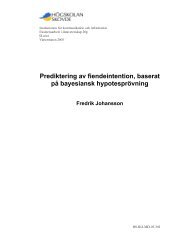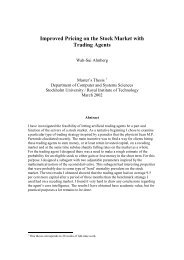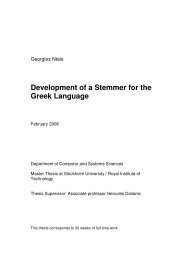Modeling Hydra Behavior Using Methods Founded in Behavior-Based Robotics
Modeling Hydra Behavior Using Methods Founded in ... - SAIS
Modeling Hydra Behavior Using Methods Founded in ... - SAIS
Create successful ePaper yourself
Turn your PDF publications into a flip-book with our unique Google optimized e-Paper software.
Chapter 7Results and discussionIn this chapter the result<strong>in</strong>g behavioral model of <strong>Hydra</strong> is presented. The process of model<strong>in</strong>gthe overall behavior of <strong>Hydra</strong> was carried out <strong>in</strong> two steps: (1) Generation of theconstituent behaviors <strong>in</strong>volved <strong>in</strong> <strong>Hydra</strong>’s overall behavior. <strong>Us<strong>in</strong>g</strong> the CSA, this amountsto def<strong>in</strong><strong>in</strong>g an appropriate AC as well as a TF for each behavior. (2) Generation of thebehavioral organizer, i.e. organiz<strong>in</strong>g the constituent behaviors <strong>in</strong>to layers, and def<strong>in</strong><strong>in</strong>gthe <strong>in</strong>teract<strong>in</strong>g connections. The two steps were carried out <strong>in</strong>dependently of each other.This chapter starts with a presentation of the results concern<strong>in</strong>g each of the constituentbehaviors, and concludes with a description of the overall behavior of the simulated <strong>Hydra</strong>.7.1 Generation of behaviorsThe four constituent behaviors of <strong>Hydra</strong>, as described <strong>in</strong> Section 5.1.3, were generated <strong>in</strong>dependentlyof each other. However, as mentioned <strong>in</strong> Section 6.1.1, the behavioral outputof B1-B3 share some characteristics, namely how <strong>Hydra</strong> should allocate its time betweencontracted and extended states, as well as <strong>in</strong> locomotion, depend<strong>in</strong>g on the animal’s motivationalstate. Thus, the transfer functions of B1-B3 share the task of evok<strong>in</strong>g a CP or anLP, whichever is applicable, at the appropriate po<strong>in</strong>t <strong>in</strong> time, assum<strong>in</strong>g that the particularbehavior is the active one.It should be noted that each behavior is a self-conta<strong>in</strong>ed unit, operat<strong>in</strong>g only at a locallevel. Hence, a behavioral unit is not supplied with any <strong>in</strong>formation concern<strong>in</strong>g the otherbehaviors <strong>in</strong>cluded <strong>in</strong> the implemented behavior repertoire. It is therefore worth stress<strong>in</strong>gthat, while the applicability clause of each behavior determ<strong>in</strong>es whether the output fromits transfer function should be active or not, the selection of which behavioral output thatis f<strong>in</strong>ally passed on to the actuators is carried out by the behavioral organizer. The resultsfrom the generation of the ACs as well as the TFs for each of the constituent behaviors <strong>in</strong>27





